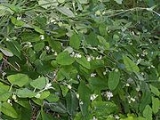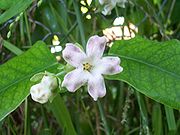
Araujia sericifera
Encyclopedia
Araujia sericifera is a perennial ornamental plant
in the genus Araujia
belonging to Apocynaceae
family. This plant has been described in 1818 by the Portuguese botanist Félix Avelar Brotero
. Its common names include , Moth Plant, White Bladderflower, Common Moth Vine and Cruel Vine.
(1754–1817), a portuguese amateur botanist who conducted scientific studies and experiments in his own botanical garden. The Latin name sericifera of the species, meaning silk-bearing, refers to the silky hairs surrounding the seeds inside the fruits.
 Araujia sericifera is a creeping vine that can climb up to 5–7 m (16.4–23 ) of height. If broken this plant releases a milky smelly exudate. Leaves are opposite, dark green, glossy and quite fleshy, almost triangular, with entire margins, about 10–12 mm (0.393700787401575–0.47244094488189 ) long.
Araujia sericifera is a creeping vine that can climb up to 5–7 m (16.4–23 ) of height. If broken this plant releases a milky smelly exudate. Leaves are opposite, dark green, glossy and quite fleshy, almost triangular, with entire margins, about 10–12 mm (0.393700787401575–0.47244094488189 ) long.
The twining stems bear plenty of fragrant, chalice-shaped bisexual flowers, of about 2 centimetre (0.78740157480315 in) of diameter,with five white, creamish, violet or pale pink petals. The flowers are usually pollinated by moths (hence the common name of the plant), butterflies and bees (entomophily
), but they are capable of automatic self-pollination. The flowering period extends from July through September. The pear-shaped fruits are large pods of about 8–10 cm (3.1–3.9 ) of length. They contain numerous black seeds surrounded by silky hairs which enable them to be dispersed by the wind.
The fast-growing vines can cover a tree canopy in two or three years, competing with the tree for light, water, and nutrients. They damage trees by this competition and by twining so tightly around their branches that it girdles
them.
and in many other countries as an ornamental plant, but it is now considered a noxious weed. Nowadays its geographical distribution includes southern Europe
, south Africa
, North America
(California
, Georgia
), South America
(Argentina
, Brazil
, Paraguay
, Uruguay
), Australia
and New Zealand
.
Ornamental plant
Ornamental plants are plants that are grown for decorative purposes in gardens and landscape design projects, as house plants, for cut flowers and specimen display...
in the genus Araujia
Araujia
Araujia is a small genus of perennial vines in the dogbane family. There are about five species native to South America.Species include:*Araujia megapotamica*Araujia sericifera - white bladderflower, cruel vine-External links:**...
belonging to Apocynaceae
Apocynaceae
The Apocynaceae or dogbane family is a family of flowering plants that includes trees, shrubs, herbs, and lianas.Many species are tall trees found in tropical rainforests, and most are from the tropics and subtropics, but some grow in tropical dry, xeric environments. There are also perennial herbs...
family. This plant has been described in 1818 by the Portuguese botanist Félix Avelar Brotero
Félix Avelar Brotero
Félix Avellar Brotero was a Portuguese botanist and professor. He fled to France in 1788 to escape persecution by the Inquisition, and there published his Compendio de Botanica in order to earn his living...
. Its common names include , Moth Plant, White Bladderflower, Common Moth Vine and Cruel Vine.
Etymology
The genus name (Araujia) derives from António de Araújo e Azevedo, 1st Count of BarcaAntónio de Araújo e Azevedo, 1st Count of Barca
António de Araújo e Azevedo, 1st Count of Barca was a Portuguese statesman, author and amateur botanist. After cooperating in the establishment of the Academia de Ciências at Lisbon, he represented his government in Holland, France, Prussia, and Russia...
(1754–1817), a portuguese amateur botanist who conducted scientific studies and experiments in his own botanical garden. The Latin name sericifera of the species, meaning silk-bearing, refers to the silky hairs surrounding the seeds inside the fruits.
Description

The twining stems bear plenty of fragrant, chalice-shaped bisexual flowers, of about 2 centimetre (0.78740157480315 in) of diameter,with five white, creamish, violet or pale pink petals. The flowers are usually pollinated by moths (hence the common name of the plant), butterflies and bees (entomophily
Entomophily
Entomophily is a form of pollination whereby pollen is distributed by insects. Several insect are reported to be responsible for the pollination of many plant species, particularly bees, Lepidoptera , wasps, flies, ants and beetles. Some plant species co-evolved with a particular pollinator, such...
), but they are capable of automatic self-pollination. The flowering period extends from July through September. The pear-shaped fruits are large pods of about 8–10 cm (3.1–3.9 ) of length. They contain numerous black seeds surrounded by silky hairs which enable them to be dispersed by the wind.
The fast-growing vines can cover a tree canopy in two or three years, competing with the tree for light, water, and nutrients. They damage trees by this competition and by twining so tightly around their branches that it girdles
Girdling
Girdling, also called ring barking or ring-barking, is the complete removal of a strip of bark from around the entire circumference of either a branch or trunk of a woody plant. Girdling results in the death of wood tissues beyond the damage...
them.
Distribution
This plant native to South America was introduced in EuropeEurope
Europe is, by convention, one of the world's seven continents. Comprising the westernmost peninsula of Eurasia, Europe is generally 'divided' from Asia to its east by the watershed divides of the Ural and Caucasus Mountains, the Ural River, the Caspian and Black Seas, and the waterways connecting...
and in many other countries as an ornamental plant, but it is now considered a noxious weed. Nowadays its geographical distribution includes southern Europe
Europe
Europe is, by convention, one of the world's seven continents. Comprising the westernmost peninsula of Eurasia, Europe is generally 'divided' from Asia to its east by the watershed divides of the Ural and Caucasus Mountains, the Ural River, the Caspian and Black Seas, and the waterways connecting...
, south Africa
Africa
Africa is the world's second largest and second most populous continent, after Asia. At about 30.2 million km² including adjacent islands, it covers 6% of the Earth's total surface area and 20.4% of the total land area...
, North America
North America
North America is a continent wholly within the Northern Hemisphere and almost wholly within the Western Hemisphere. It is also considered a northern subcontinent of the Americas...
(California
California
California is a state located on the West Coast of the United States. It is by far the most populous U.S. state, and the third-largest by land area...
, Georgia
Georgia (U.S. state)
Georgia is a state located in the southeastern United States. It was established in 1732, the last of the original Thirteen Colonies. The state is named after King George II of Great Britain. Georgia was the fourth state to ratify the United States Constitution, on January 2, 1788...
), South America
South America
South America is a continent situated in the Western Hemisphere, mostly in the Southern Hemisphere, with a relatively small portion in the Northern Hemisphere. The continent is also considered a subcontinent of the Americas. It is bordered on the west by the Pacific Ocean and on the north and east...
(Argentina
Argentina
Argentina , officially the Argentine Republic , is the second largest country in South America by land area, after Brazil. It is constituted as a federation of 23 provinces and an autonomous city, Buenos Aires...
, Brazil
Brazil
Brazil , officially the Federative Republic of Brazil , is the largest country in South America. It is the world's fifth largest country, both by geographical area and by population with over 192 million people...
, Paraguay
Paraguay
Paraguay , officially the Republic of Paraguay , is a landlocked country in South America. It is bordered by Argentina to the south and southwest, Brazil to the east and northeast, and Bolivia to the northwest. Paraguay lies on both banks of the Paraguay River, which runs through the center of the...
, Uruguay
Uruguay
Uruguay ,officially the Oriental Republic of Uruguay,sometimes the Eastern Republic of Uruguay; ) is a country in the southeastern part of South America. It is home to some 3.5 million people, of whom 1.8 million live in the capital Montevideo and its metropolitan area...
), Australia
Australia
Australia , officially the Commonwealth of Australia, is a country in the Southern Hemisphere comprising the mainland of the Australian continent, the island of Tasmania, and numerous smaller islands in the Indian and Pacific Oceans. It is the world's sixth-largest country by total area...
and New Zealand
New Zealand
New Zealand is an island country in the south-western Pacific Ocean comprising two main landmasses and numerous smaller islands. The country is situated some east of Australia across the Tasman Sea, and roughly south of the Pacific island nations of New Caledonia, Fiji, and Tonga...
.

